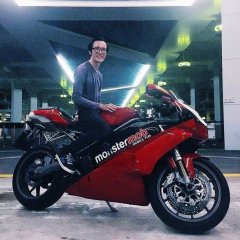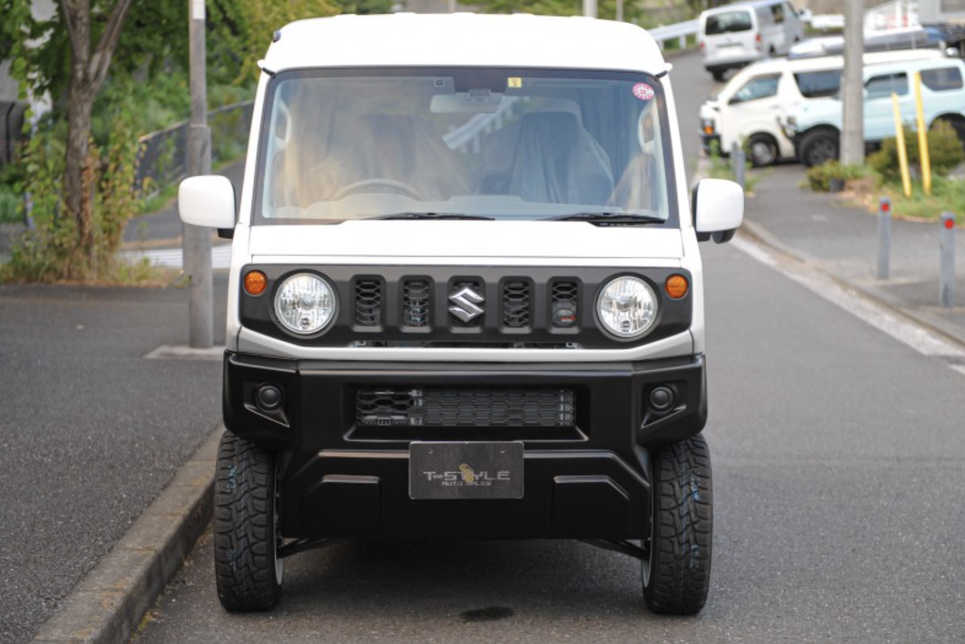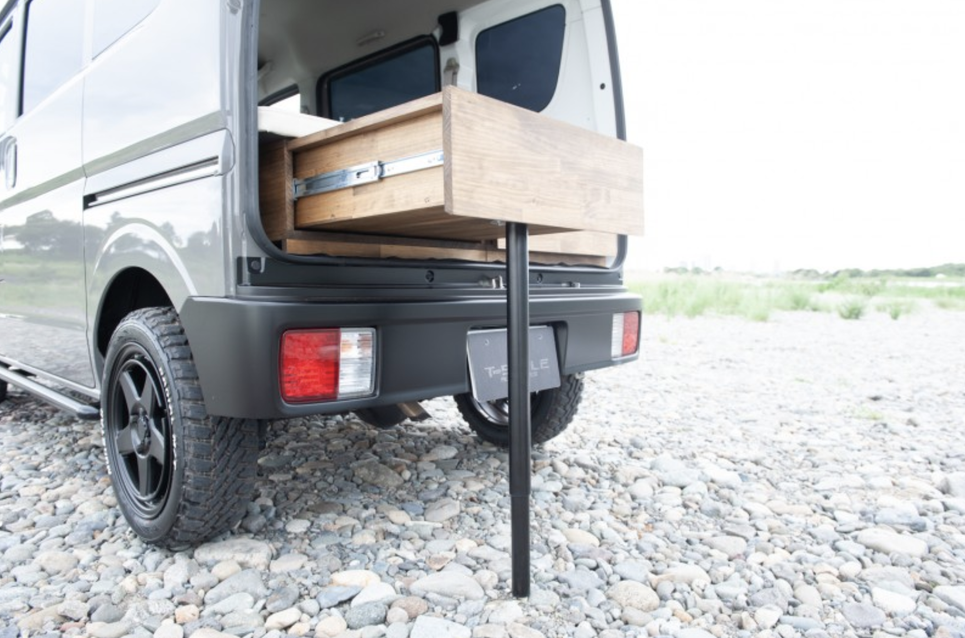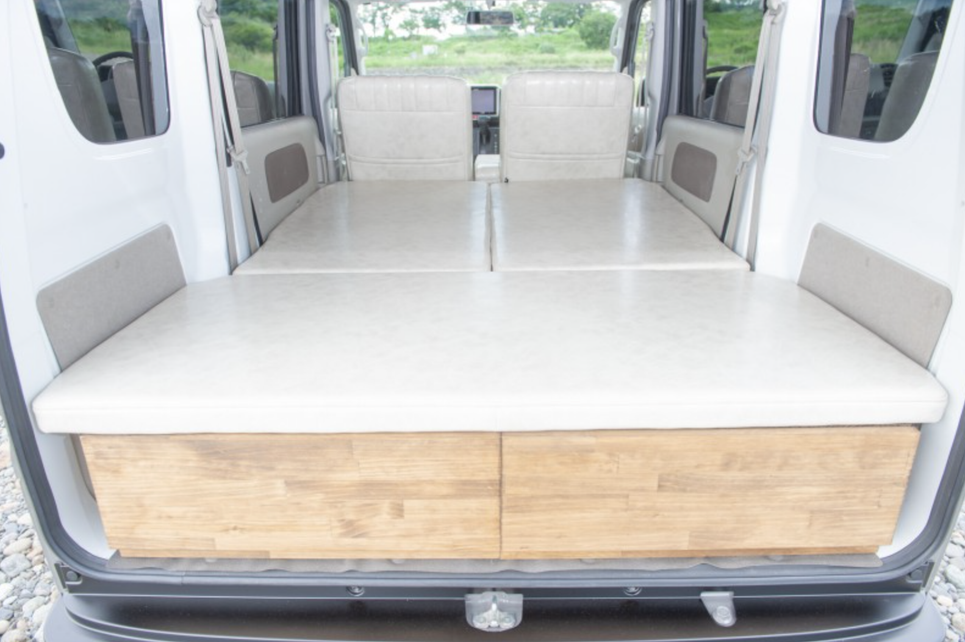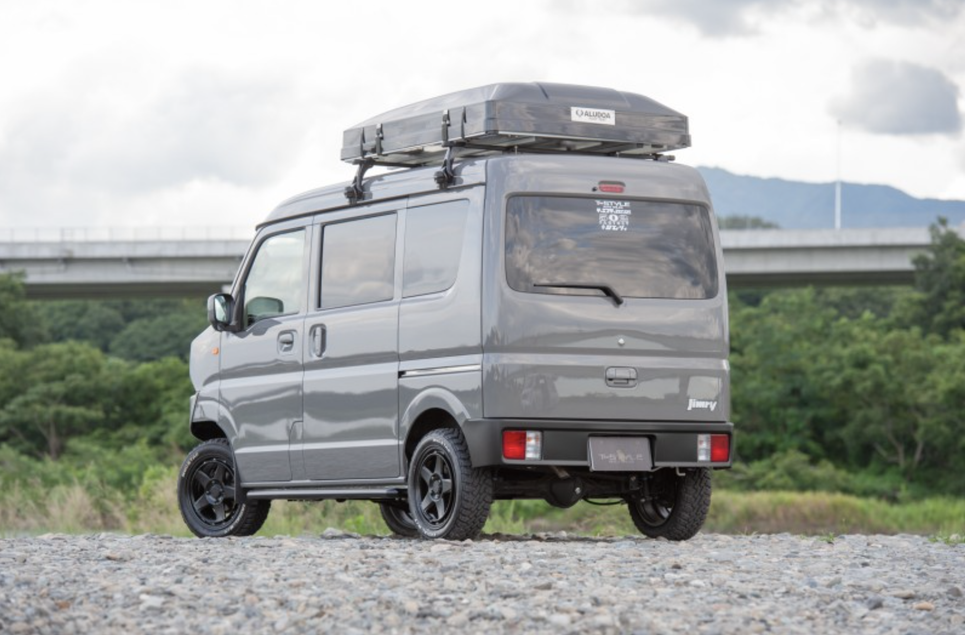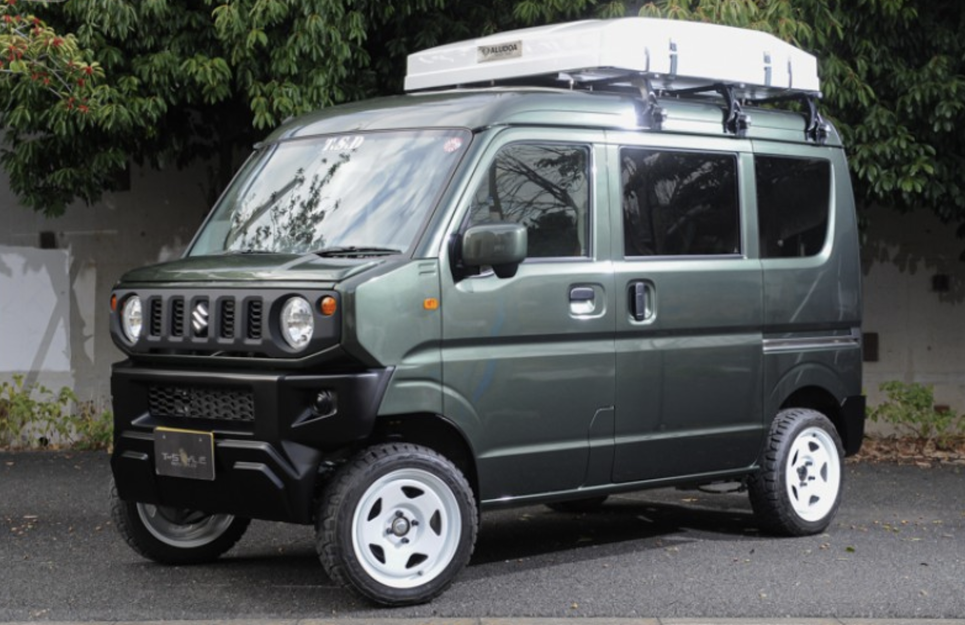Search the Community
Showing results for tags 'raised'.
-
<The Suzuki Jimny Fuses With The Suzuki Every To Make The Cutest Overland Kei Car The custom Jimry is a Jimny with a sleeper compartment. Kind of. Photo: T-Style A tuner in Yokohama, Japan combined the looks and off-road capability of the Suzuki Jimny with the passenger capacity and space efficiency of the Suzuki Every. The combination producing what T-Style Design calls the Suzuki Jimry, an overland kei car that may not have the off-road chops of the Jimny, but certainly has the attitude. This is probably as close as we’ll get to a Jimny with sliding van doors and I love it. The Jimry is built using the Suzuki Every as a base according to Autocosmos, but it has some modifications to its suspension that make it more trail worthy. Photo: T-Style The stock Suzuki Every sits almost 6 inches off the ground, and the Jimry mods raise it by 1.5 inches for a total of 7.5 inches of ground clearance. The stock 13-inch tires are replaced by 14- or 15-inch tires, depending on the build. Some Jimry builds are 4WD, but not all. And others get even more ground clearance, up to four inches over stock. The Jimry keeps the Every’s 660cc three-cylinder engine to comply with Kei car regulations. That engine makes about 63 horespower and 70 lb-ft of torque. Many of the conversions from TSD come with a five-speed manual transmission, but some get an automatic gearbox. Other gear includes a top box and rooftop tent, along with custom mudguards and bumpers that add to the Jimny look. Of course, it wouldn’t be complete without the Jimny grille. The grille sits below what looks like the tiniest “hood” ever, but since the Suzuki Every is a cabover design, the hood is not covering an engine. And I’m unsure if it’s the stocky dimensions or stand-offish front end but I’m getting Hummer H2 vibes. Even then, I still can’t help but love all the Jimry builds. Photo: T-Style Photo: T-Style The mods keep going into the interior, which has slide-out storage compartments beneath a modular bed. The bed sits atop the rear seats when these are folded and it takes up the entire rear portion of the cabin. That’s only in one of the Jimry builds advertised by TSD, and it looks like the mods are made to suit the owner. Prices for the Jimry range from $21,725 to $22,337 or so. That’s for whole Jimry builds. Autocosmos reports that the modifications alone start at around $2,178. Photo: T-Style Photo: T-Style Photo: T-Style Photo: T-Style Photo: T-Style>
-
Development charge rates raised by an average of 9.8% for non-landed residential land use https://www.businesstimes.com.sg/real-estate/development-charge-rates-raised-by-an-average-of-98-for-non-landed-residential-land-use?xtor=CS3-25 New private homes to cost up to S$2,900 psf on average by 2030: DBS report https://www.todayonline.com/singapore/new-private-homes-could-cost-s2900-psf-2030-dbs-report
-
- 2
-

-
- developement charge
- tax
-
(and 6 more)
Tagged with:
-
The Government is raising emission standards for new petrol vehicles and petrol quality to ensure cleaner air for all, and increasing the frequency of updates on Singapore's air quality. The announcement was made by Minister for the Environment and Water Resources Vivian Balakrishnan at the Singapore Environmental Achievement Awards 2012 today. The measures are part of the National Environment Agency's (NEA) roadmap to reduce sulphur dioxide and particulate matter levels in the air in order to meet the World Health Organization's Air Quality Guidelines. From tomorrow, the NEA will be updating the Pollutant Standards Index (PSI) thrice daily instead of once a day, to make air quality information more relevant to Singaporeans. In addition, PM 2.5 levels - a pollutant emitted from the petrochemical industry and diesel vehicles - will also be made available with the PSI readings. Source: http://www.todayonline.com/Hotnews/EDC1208...es-to-be-raised
-
http://www.channelnewsasia.com/news/singapore/re-employment-age-raised/2678966.html Dear bros, Do you think that the government will raise the age that you can start withdrawing from the CPF Retirement Account from the current 65 to 67 in 2017?
- 241 replies
-
- 4
-

-
- cpf
- retirement age
-
(and 4 more)
Tagged with:
-
Are those raise rectangular humps (not semi circular) with vertical yellow/black stripes meant for pedestrian crossings or just to slow down traffics? usually found along HDB service roads...
-
SINGAPORE: From January next year, the Medisave Required Amount (MRA) in the Central Provident Fund (CPF) will be raised to S$38,500 from the current S$32,000. The MRA refers to the amount that must be set aside in the Medisave Account, after the CPF Minimum Sum requirement has been met. The CPF Board said those who have met the CPF Minimum Sum and have an MRA shortfall at the point of withdrawal have to make a top-up to the Medisave Account. This can be done with part of the balances from the Ordinary Account and/or Special Account to meet the prevailing MRA. CPF said the requirement for members to set aside the MRA in their Medisave Account is to enable them to have enough savings to meet their healthcare needs during old age. Central Provident Fund members will also continue to enjoy a risk free interest rate of four percent on their Special and Medisave Accounts (SMA) for the next three months, from 1 January to 31 March 2013. The interest rate on their Retirement Accounts (RA) for the whole of next year will also remain at four percent. The CPF Board said this was in line with the government's announcement in September that it would maintain the four percent per annum floor rate for interest earned on all monies in the Special and Medisave Accounts as well as savings in the Retirement Account until the end of next year. Savings in the SMA currently earn either 4 percent or the 12-month average yield of 10-year Singapore Government Securities (10YSGS) plus 1 percent, whichever is the higher. The interest rate on SMA savings is adjusted quarterly, based on interest rates on 10YSGS over a preceding 12-month period. Since the average yield of the 10YSGS plus 1 percent, from 1 December 2011 to 30 November 2012, works out to be 2.49 percent, the SMA interest rate payable to CPF members from 1 January 2013 to 31 March 2013 will be maintained at the current floor of 4 percent, CPF said. New RA savings are invested in SSGS which earn a fixed coupon equal to either the 12-month average yield of the 10YSGS plus 1 percent at the point of issuance, or 4 percent, whichever is the higher, adjusted yearly. CPF said given the lower 10YSGS yield, new RA savings will earn a fixed coupon of 4 percent. - CNA/al http://www.channelnewsasia.com/stories/sin...1243869/1/.html
-
Good move to reduce FT flooding in and straining our infrastucture. But now we know the reason behind the surge in FTs for the past couple of years. $2800/mth can bring in parents, in-laws, spouse and children? [sINGAPORE] First, higher levies and stricter work pass conditions made it harder for foreigners to work here. Now, foreigners will also find it tougher to keep their families here, under a new rule announced on the Ministry of Manpower's (MOM) website on Monday. For Singaporeans, this move might mean fewer foreigners competing for limited space in local schools, hospitals and trains. But the city-state might also be less attractive to some lower-earning skilled foreigners who will now have to work here without their spouses or children. From Sept 1, MOM said in a posting on its website, S Pass and Employment Pass (EP) holders need to earn at least $4,000 monthly before they can sponsor a Dependant's Pass for their spouses and children. The salary requirement is up from $2,800 previously. The Dependant's Pass is a privilege that allows foreigners to stay here for longer periods of time, and is tied to the duration of the sponsor's work pass. Dependants can also apply for Letters of Consent to work here, without having to apply for a work pass. For all EP holders, their parents-in-law are no longer allowed to stay here. Those earning more under the EP framework will face progressively fewer restrictions. P2 Pass holders, who earn at least $4,500, can bring their spouses and children, but will no longer be able to bring their parents or parents-in-law. P1 Pass holders, who earn at least $8,000, can still bring their parents in addition to their spouses and children - just not their parents-in-law. Meanwhile, P1 and P2 Pass holders can also still apply for long-term visit passes for other categories like common-law spouses, their children, and handicapped children and stepchildren aged above 21. Explaining the changes, MOM said: "The government is making this move as part of the overall direction to moderate growth of the non-resident population, including the foreign workforce inflow, in Singapore. "This will help ease the pressure on our social infrastructure," it said. MOM advised companies not to make a "knee- jerk reaction" to the tightening of dependant privileges, as MOM will continue to approve Dependant's Pass applications before Sept 1. Current dependants can also stay in Singapore as long as the main pass holder has a valid work pass and remains with the same employer. MOM's move is the latest in a series of moves by various ministries to sharpen the privileges of being Singaporean and restrict the influx of foreigners which has strained the city's infrastructure and caused locals considerable angst in the last few years. For example, qualifying salaries for EP holders were raised to $3,000 in January along with stricter educational requirements. Higher foreign worker levies and tighter foreign worker quotas kicked in earlier this month. MOM, however, stressed that Singapore "remains a global talent capital" and continues to welcome highly skilled foreign talent who want families to stay with them. Observers say that the latest change affects young graduates looking to work here who earn wages in the $2,800-$4,000 range. Teo Siong Seng, president of the Singapore Chinese Chamber of Commerce and Industry, said: "I don't understand the rationale. Do support and give priority to Singaporeans, but we must also open up to talented people. Those who are younger and just started work, just married, might be discouraged from coming to work here as it is harder to part from their spouses." Similarly, Annie Yap, managing director of recruiter AYP Associates, said that "quite a lot of foreigners earn in the $2,800- $4,000 range", so the move will deter some from continuing to work here. Others are divided on whether the move will have an impact on Singapore's attractiveness to talent. Singapore National Employers Federation executive director Koh Juan Kiat pointed out that other countries have similar restrictions for dependants. Lim Der Shing, chief executive of online recruitment portal JobsCentral, said that Singapore is such an expensive place to live in anyway that it is likely that only those earning $4,000 and above are bringing dependants in. "For my company, people on S Passes and EPs don't bring their dependants over unless both husband and wife are working," he added. Chan Chong Beng, president of the Association of Small and Medium Enterprises, said the move is a good one. "Our infrastructure today is quite jammed and will need some time to be ready for more people. This will ease the pressure," he said. Ultimately, the move might be good in the short term but may have an unintended consequence in low-fertility Singapore, which is trying hard to solve its demographic problems, said sociologist Paulin Straughan, an associate professor at NUS. She said that the new rule will encourage a "guest-worker" mentality among foreign workers earning less than $4,000 a month. They will more likely be single and willing to work longer hours for lower wages, Prof Straughan said. "We're no longer going to be attractive to married individuals who can fill in the kind of jobs people in that salary range usually take - essentially service sector jobs. "This changes the nature of work. You will have foreigners come in who are single, and their only intention is to make as much money as they can and go home - as, obviously, they are not welcome here," Prof Straughan added. "That's a pity. Because when the entire family is here, the way the guest worker leads his or her family life will be very different. "They will be more like regular Singaporeans, keeping regular hours to have a good work-life balance."
- 23 replies
-
- raised
- foreigners
- (and 4 more)
-
DPM Tharman: Government revenues need to be raised. New ways to raise revenue needed, says DPM Tharman 04:46 AM Mar 02, 2012 by Neo Chai Chin SINGAPORE - As the Government ramps up healthcare spending, keeps up social mobility and gives a leg-up to society's lowest wage earners, it will also need to find new ways of raising revenue after 2016, said Deputy Prime Minister Tharman Shanmugaratnam yesterday as he wrapped up the three-day Budget debate. Even as he affirmed a judicious spending approach to avoid a heavy tax burden on middle-income earners, he rolled out examples to illustrate how the Government has addressed inequality, while promising to look into suggestions raised by Members of Parliament. Mr Tharman, who is also Finance Minister, noted that low-income households received over S$4 in benefits - through schemes like Workfare, housing and education subsidies - for every dollar of tax they pay. The Government pledged to do more for low-wage workers like cleaners and security guards. The Manpower Ministry is working with the National Environment Agency to help cleaners, and with the Home Affairs Ministry in the case of security guards, said Mr Tharman. Healthcare spending over the next 20 years will go up from the current 1.6 per cent of gross domestic product (GDP), to 3.5 per cent of GDP by 2030, said Mr Tharman. For the elderly, the amount of money from the Silver Housing Bonus and Lease Buyback Scheme to be locked up for the CPF Life scheme will be reviewed over the next two months. The suggestion to further tap risk-pooling and enhance portable medical insurance will be studied. Refuting the perception of some that the sandwich class - squeezed by costs of caring for aged parents and young children - were somewhat left out of this year's Budget, Mr Tharman said the Medisave top-ups the middle-income group will receive via the GST Voucher will be enough to fund half their annual Medisave withdrawals on average. But the Government's basic strategy to help the middle-income group is to ensure real wages rise and tax burden remains low. A "fair tax system" must be sustainable, "not just for five or 10 years, but well into our children's generation", stressed Mr Tharman. Beyond 2016, the Government will have to find new sources of revenues, including tax revenues. "For these five years, we're okay and that's why we're setting aside monies in trust funds and endowment funds to fund future spending whilst we still have the resources," he said. "But in the 10 to 15 years after 2016, we do have a real challenge, and we'll have to think beyond growing the economy and sustaining revenues based on GDP growth." Mr Tharman rejected Workers' Party chairman Sylvia Lim's suggestion to increase spending on healthcare to 6.1 per cent of GDP, as in the OECD. According to Mr Tharman, it would mean one of three scenarios: GST has to rise to about 20 per cent, corporate income taxes have to rise to about 40 per cent, or personal income taxes will have to rise to a top-line rate of about 60 per cent. Instead, he felt, the focus should be on outcomes. URL http://www.todayonline.com/Singapore/EDC12...ays-DPM-Tharman Copyright 2012 MediaCorp Pte Ltd | All Rights Reserved Moral of the story: sometimes its not just all about just money, oftentimes, some heart ware too is very necessary. ~ Matthew 25:40: "The King will reply, 'I tell you the truth, whatever you did for one of the least of these brothers of mine, you did for me.'"- (NIV) Regards B.C.
- 22 replies
-
- Tharman
- Government
-
(and 3 more)
Tagged with:
-
SINGAPORE: Prime Minister Lee Hsien Loong said employers' contribution rates to the Central Provident Fund for older workers have to go up, but added that any increases will have to be gradual. Mr Lee revealed this at a pre-Budget dialogue with unionists last week. Currently, CPF contribution rates are cut when workers reach 50 years old, and cut further when they turn 65. The labour movement, NTUC, has been calling for this to be reviewed. This too, comes at a time when Singaporeans are being encouraged to work beyond their retirement. Mr Lee said the government is discussing the matter with unions and employers. But cost is a consideration. He noted for instance, that a larger proportion of older workers kept their jobs during the recession, because their CPF was lower, and so they were cheaper to retain. The government's concern here, is that once older workers lose their jobs, it's much harder for them to get back to work. Source :Increase CPF contribution to older workers I am not too sure about this proposal, with the readily available cheaper and better FT, will this scheme encourage company to retain older workers?
- 25 replies
-
- Employers
- contributions
-
(and 3 more)
Tagged with:
-
If Malaysia increases toll charges for motorists using the Causeway, Singapore is likely to follow suit. This is due to a longstanding policy of matching whatever rates Malaysia sets, said the Land Transport Authority (LTA). Motorists using the Causeway could soon pay up to five times more in charges, Malaysian newspaper The Star reported recently. Under the proposed revision, they will have to pay tolls both ways, which are likely to be at higher rates. source: http://www.straitstimes.com/BreakingNews/S...ory_765465.html
-
Darn
-
Speaking at the National Day Rally, Prime Minister Lee Hsien Loong said that this move was due to young couples' incomes increasing recently.
- 110 replies
-
- Qualifying
- income
- (and 4 more)
-
http://www.thestar.com.my/news/story.asp?f...&sec=nation PETALING JAYA: The price of premium RON97 petrol will be increased by 20 sen to a record high of RM2.90 per litre from Thursday. "The price of RON97 fluctuates as the Government has lifted the subsidy for this petrol," Malaysian Petrol Dealers Association president Datuk Hashim Othman said Wednesday when confirming the price increase. The previous increase was a month ago. "The price of RON97 might go down in future, but this depends on the political situation in the Middle East as well as natural disasters," he added. Subsidised RON95 petrol and diesel prices remain unchanged.
-
We need more opposition like her to perform the checks and balances of the PAP. I hope there would be many willing to support her. Check out her speech: http://m.youtube.com/#/watch?xl=xl_blazer&v=pIJzks6ByRs
-
Reason for property tax hike http://business.asiaone.com/Business/My%2B...122-181541.html Sun, Nov 22, 2009 The Straits Times By Sue-Ann Chia SENIOR POLITICAL CORRESPONDENT THE property tax of HDB flats is being raised next year partly to avoid having to introduce a bigger increase later should home prices continue to rise, said Acting Minister for Information, Communications and the Arts Lui Tuck Yew. He gave the reason on Sunday when he was asked, at a dialogue with Aljunied-Hougang residents, whether the Government could have delayed it since the recession has just started to ease. Noting that the adjustment had been delayed once, in 2008, Rear-Admiral (NS) Lui said: 'The problem is the longer you defer it, the larger the increase will be in the property taxes if HDB prices continues to go up.' So will the property tax be lowered if the home price drops??? seems that Govt wants to take money from peasant first...how abt introducing further pay cut to all ministers inorder to forecast high inflation....
-
his is the first picture of a five-year-old 'Mowgli' girl raised by dogs after her parents neglected her. Natasha Mikhailova was kept locked in a room with dogs and cats for several years, causing her to behave like an animal. She does not speak, laps up her food and drink with her tongue, and walks on all fours. Though living in filthy conditions in the same home as her father Viktor Lozhkin, 27, and grandparents in the Siberian city of Chita, child experts say she was treated as a family pet. Lozhkin and the girl's mother Yana Mikhailova, 25, who has had no contact with her for two years, were both arrested on suspicion of neglect. 'They never let her out, we didn't know she existed,' said one neighbour. 'They have three really vicious and angry ones which they took for walks - but we never saw this child.' The girl is the size of a two-year-old and was not registered with doctors or hospitals. Natasha is now under close observation at a social rehabilitation centre. Specialists are shocked at the way she jumps on people and plays dog games yet they say she is not mentally disabled. 'When I went out of the room, she jumped at the door and started barking, not just mewing or something, but barking,' said Nina Yemelchugova, chief of the centre. 'She eats well, she's got a good appetite but she can't behave at the table, she throws away the spoon and laps up food from the plate.' Natasha shuns the company of other children and gets nervous when she hears unexpected noises. Police chief Larisa Popova said officers entered the flat on Monday after a tip-off from neighbours. 'We had to fight to get this girl away,' she said. Her father not there but the dogs sought to protect her. 'The child was living in absolute filthy conditions, the flat smells awful. There were a lot of animals, dogs and cats, and the girl was living with them. 'When we went into the flat we were almost knocked over by the stink.' Natasha was wearing torn and soiled clothes. Yekaterina Novikova, who lives nearby, said: 'These neighbours are unsociable, they only come out at night or early in the morning to avoid meeting with other locals and they never open the door.' The mother, who has three other children living at another address, was arrested after going to police following local TV coverage of the girl being taken into care. She claimed that Natasha had been 'kidnapped' by her father several years ago, but seems to have made no effort to get her back. Experts hope Natasha can recover with intensive education. She showed delight when an art teacher drew a picture of a flower. The parents could face around three years in jail, according to Russian media reports.
-
hi , apart from cutting the bonet or to change to vented ones... to raise the rear part of the bonet to vent heat, qns is how much to be raise. hear before from workshop. raise abt 12~15mm the gap. is it good? wat is recommended? adv : heat wont trap under bonet , lower temp. disadv : those go outside car wash, water may jet into engine bay. ------------------------------------------------------------------------------------------ i tot of raising the rear to vent heat. at the same time. put rubber sponge to block from the passenger side to the after-the-fusebox to prevent heavy rain from splashing at the batt and fuse box. <-- thats where the fuse box and batt are. well the driver side of the car is not so much of electrical though. and while moving is not so much of a issue to water enter from gap. only worry if go car wash... inside spray like swimming pool ahhaha.
-
ST 13/4 Claims are sometimes larger than those for repairs, and they are driving premiums up Motor insurers, which have been battling the scourge of inflated repair bills for years, are now facing a new monster: injury claims arising from road accidents, and not all of them appear to be genuine. Industry players said the claims, which are sometimes many times larger than those for vehicle repairs, are costing insurers an arm and a leg in payouts and driving premiums up for motorists. One leading insurer said it received on average 300 injury claims a month last year - more than double the 140 a month it received in 2006. Another top motor insurer, Axa Insurance, said its volume this year has already exceeded last year's by up to 20 per cent, with whiplash, cuts and abrasions forming the bulk of claims. 'There is a worry about a rising trend in orchestrated injury claims,' Mr Derek Teo, president of the General Insurance Association (GIA), told The Sunday Times. 'Very often, they would pertain to whiplash, which is hard to substantiate or refute.' Last month, the GIA announced an initiative which it hopes will reduce inflated claims. From next month, motorists involved in an accident will have to inform their insurers within 24 hours. Industry sources said this was because people were less likely to lie or would have fewer opportunities to collaborate with workshops to submit inflated claims within the first 24 hours of an accident. But observers pointed out that the new plan would not address rising injury claims, which were sometimes filed days after an accident. Police statistics show that over 44,000 people were 'slightly injured' on the road between 2003 and last year. The annual figure crossed the 10,000-mark last year to hit 10,250 - 30 per cent more than in 2003 and outpacing the 16.5 per cent growth in vehicle population since then. Private investigator Louis Amalorpavanathan of GLA Claims Adjusting and Investigation Services said injury claims have shot up over the last year. He blamed lawyers. 'Most insurance companies are now encouraging direct settlement for repair claims, bypassing lawyers who used to be involved,' he said. He explained that this resulted in less business for some lawyers who specialised in accident claims, prompting them to scour for injury cases to represent. Lawyer Monoj Kumar Roy, 47, had this to say in retort: 'That's an unfair statement. Many people in the past did not know they could claim for injuries. How can lawyers drive injury claims if there are no injuries?' He added: 'Admittedly, there are odd cases of fakes. If insurers think there is no injury, they should fight the case and get it thrown out.' Another new development could affect the business of lawyers. As of last month, disputes arising from non-injury motor accident claims below $1,000 are no longer heard in court. Instead, they go straight to the Financial Industry Disputes Resolution Centre (Fidrec), an independent resolution centre set up in 2005. The Sunday Times understands the $1,000 cap may be reviewed - and possibly raised - in future. According to industry sources, the Subordinate Courts may soon make a similar move to outsource injury claim disputes to Fidrec because the number of such cases had exploded. The Subordinate Courts said a workplan rolling out soon would include changes in this area, but declined to go into details of injury claims being handled now. The move to divert non-injury accident claim disputes to Fidrec is expected to shave about 1,000 cases off the courts' workload.
-
To the driver of the silver Hyundai Matrix OPC travelling on Tampines St 45 earlier this morning at around 6.50am : Your attempt to overtake me on the zebra crossing was downright foolish, selfish & just shows complete disregard to traffic rules. I stopped in front of the raised crossing as there was a few school children crossing over to the bus stop ahead. You came up from behind and was to my right, ready to just dash over. If I had not looked into my mirror & saw that you were not slowing down enough, and had I not blared my horn (even though I was ahead of you), you'd have most probably mowed down the poor child in the middle of the raised crossing. The child, if you recall, was stunned for a few moments after you jammed on the brakes. Now, as I'm driving an OPC myself & while I can understand the feverish rush one has to make when one has overslept (or whatever caused the delay) in order to make the 7am no-move timing, such driving behaviour is still unjustified. Think about it, if you're really late, how much is $20 for the coupon or even a $10K fine for not having one displayed after 7am, compared to one innocent human life? I sincerely hope that this is a one-off incident on your part. Please remember, NEVER, EVER, attempt to overtake recklessly no matter how big of a hurry you're in. More so in an estate where there's a high volume of human traffic, and NEVER on a zebra crossing. No amount of money you can spend can ever justify the blood of a human being on your hands.
- 27 replies
-
- Overtaking
- Raised
-
(and 2 more)
Tagged with:
-
3% VEHICLE GROWTH CAP MAY NOT BE LOWERED Cap on car numbers may be raised Limit to be reviewed next year and may be raised as S'pore can support a larger car population, but ERP may be extended By Christopher Tan NEXT year was to be one to dread for motorists. The Government had said it would review the 3 per cent cap on annual vehicle growth rate then - with a mind towards lowering it. But now, it appears that the 3 per cent cap will remain, or even be raised, because of changed conditions. Advertisement However, this might come at a price - an extension of the Electronic Road Pricing (ERP) scheme to more areas. What a difference five years make. In 1999, when then-Communications Minister Mah Bow Tan announced that a review would be conducted in 2005, he said that allowing a 3 per cent growth rate might not be sustainable. He quoted a Land Transport Authority forecast then which predicted that congestion would worsen significantly despite improvements being made to the Republic's road network and public transport system. The cap was put in place in 1990, when the vehicle quota or certificate of entitlement (COE) system was introduced. A Transport Ministry spokesman told The Straits Times that 'based on current social and economic trends, a 3 per cent annual growth in vehicle population is possible'. Singapore's vehicle population has grown by an average of 2.2 per cent annually since 1993, with faster growth in the first five years mitigated by much slower growth in the next five. Car numbers have consistently outpaced overall vehicle population growth, chalking an average annual growth rate of 3.2 per cent since 1993. Even so, a Remaking Singapore workgroup remarked two years ago that the growth rate needed to be raised substantially if the Government's aim of raising car ownership to one in seven residents by 2010 (from one in 10 in 1995) was to be met. The Government had since said that it was sticking to its 2010 car ownership target; and that Singapore could accommodate a bigger vehicle population with ERP. But the ministry spokesman said in no uncertain terms that 'a larger vehicle population is possible in the medium term' only if the COE system continues to be in place, and if the ERP scheme is extended. 'As the vehicle population continues to increase, traffic conditions on all roads will deteriorate if today's road network and ERP rates persist,' she explained. She added that it would be necessary to implement ERP at locations beyond the current 45 gantries at 43 locations 'to maintain acceptable travel speeds while allowing vehicle population to grow'.
